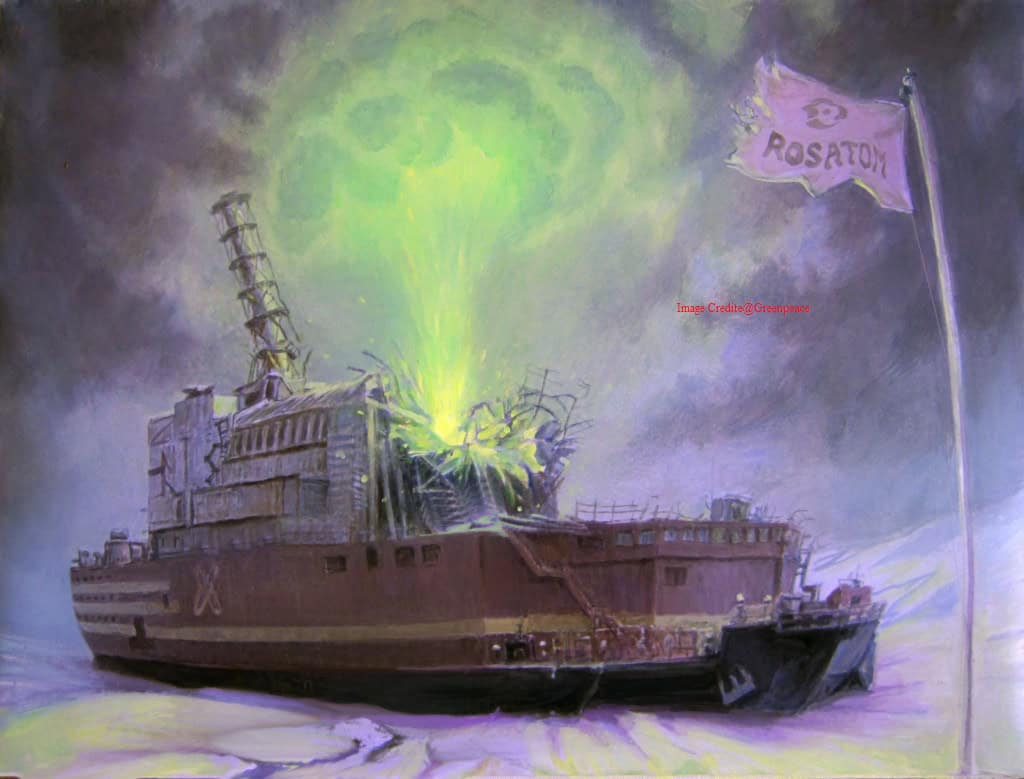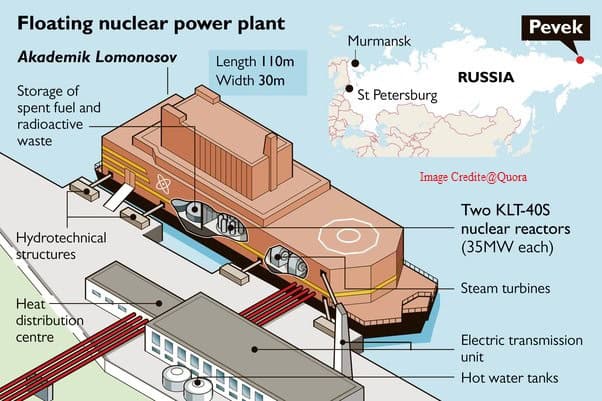Table of Contents
Introduction

Floating Nuclear Power Plants (FNPPs) are constructed on a ship rather than on solid ground. They are to generate electricity as any conventional nuclear power plant, with the exception that it can be mobilized. The function of Floating Nuclear Power Plants is to offer power supply especially in the areas which are not easily accessible through road transport and thus helps in meeting the energy demands in such places. FNPP technology has been developed for several decades since the middle of the last century, however, it has finally begun to develope faster recently. Russia has an operational FNPP, the academic Lomonosov launched in 2018.
How Floating Nuclear Power Plants Work
Floating nuclear power plants are essentially small modular reactors (SMRs) that are designed to function autonomously, independent of external power grids. Contextually, these reactors are said to be passively-cooled with superior safety features that eliminate the risk of overheating. Redundancy and resilience measures are often built into the design so that the infrastructure is guaranteed to be operational even during normal operation. FNPPs are moored near shore or docked in a harbour, connected to local power grid to deliver energy.
Fueling
Floating nclear power plants that are changing the face of the energy industry consume fuel only three years on an average. This efficiency is reflected in the following economic facts: four floating power stations save up to 200.000 metric tons of coal and up to 100.000 tons of fuel oil per one year. These reactors were designed to last for 40 years, and yet such plants are only capable of providing power for a maximum of 30 years.
Advantages of Floating Nuclear Power Plants
Floating Nuclear Power Plants offer several benefits, including:
- Mobility and flexibility: Floating Nuclear Power Plants can be moved between power demands and are suited for sites with electricity needs of a different FPS design for real property land locked can be largely matched to demand at sea in the long term with flexibility for remote or temporary needs anywhere any grid where they can be plugged in
- Potential to provide power to remote areas: The Factor Floating Nuclear Power Plants have the potential to provide power to remote, off-the-grid areas, as they do not need vast areas of land, and hence natural landscapes and the environment are conserved.
- Reduced land usage: Small floating powerplants —Floating Nuclear Power Plants can be used for healthy power supply to isolated communities, offshore installations, and regions that are affected by natural disasters
Environmental Impact
Concerns on environment aspect in relation to its health and safety has been raised with regards to the project. It is possible to blow a radioactive steam’ which will be very dangerous to those living close to the area. It also occupies an area vulnerable to earthquakes, meaning there is a high likelihood that a tsunami may affect the facility flooding it and causing radioactive substances and waste to seep out. Environmentalists have also noted that the affairs of the facility are situated on the water which makes it an easy target of force majeure situations.
Floating nuclear power plants have both positive and negative environmental impacts:
Positive impacts:
- Reduced greenhouse gas emissions:Floating Nuclear Power Plants generate electricity without emitting greenhouse gases, significantly helping to combat climate change. This is a major advantage over fossil fuel power plants, which are a major source of CO2 emissions.
- Minimized Land Disruption: Since FNPPs are stationed on water, they avoid the extensive land use and habitat disruption associated with building land-based power plants. This helps in preserving terrestrial ecosystems and biodiversity.
Negative impacts:

- Potential Marine Pollution: The operation of Floating Nuclear Power Plants poses a risk of marine pollution. Accidental discharges of radioactive material or coolant water could have severe impacts on marine life and water quality.
- Radiation Leak Risks: Although Floating Nuclear Power Plants are designed with stringent safety measures, the risk of radiation leaks remains. Such leaks could have catastrophic consequences for both marine and human life, necessitating rigorous safety protocols.
- Nuclear Waste Disposal Challenges: Managing and disposing of nuclear waste is a significant environmental challenge. FNPPs produce radioactive waste that must be carefully handled and stored to prevent environmental contamination. Long-term storage solutions are critical to mitigating the environmental risks associated with nuclear waste.
Case Studies

- Akademik Lomonosov (Russia): Russia’s Akademik Lomonosov is the world’s first floating nuclear power plant, supplying power to remote Arctic regions. It serves as a model for future Floating Nuclear Power Plants, showcasing both the potential and challenges of this technology. The environmental monitoring of its operation provides valuable data on the real-world impacts of FNPPs.
- Proposed projects in other countries: Countries such as China and the United States are exploring FNPP projects to diversify their energy sources and enhance resilience to power disruptions. These projects are also being evaluated for their environmental impacts, ensuring that future deployments are sustainable.
Future Prospects and Challenges
The future of floating nuclear power plants is promising, but several challenges need to be addressed:
- Technological Advancements: Ongoing innovation is essential to enhance the safety, efficiency, and environmental performance of FNPPs. Improvements in reactor design, waste management, and spill prevention are crucial.
- Regulatory and Safety Concerns: Developing robust regulatory frameworks and safety standards is vital for gaining public trust and ensuring the safe operation of FNPPs. International cooperation on safety protocols and environmental regulations will be key.
- Public Perception and Acceptance: Transparent communication about the benefits and risks of FNPPs is vital for public acceptance and support. Public concerns about environmental safety need to be addressed through rigorous environmental assessments and safety assurances.
Conclusion
Floating nuclear power plants are one of the type that can greatly help the globe in the energy crisis, if not all, they can help many areas which in most cases cannot accommodate conventional plants. The reason why FNPPs are overviewed is because they are effective in reductions in greenhouse gases as well as disruption to land usage; nevertheless, issues related to environment and safety should in any case be resolved to allow the deployment of FNPPs. Thus, although currently many FNPPs may be less efficient than modern large-scale power stations, and their development is facing serious obstacles due to environmental and other concerns, they can become an important part of the future power generation system.
